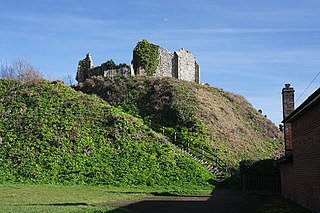 W
WBungay Castle is in the town of Bungay, Suffolk by the River Waveney.
 W
WClare Castle is a high-mounted ruinous medieval castle in the parish and former manor of Clare in Suffolk, England, anciently the caput of a feudal barony. It was built shortly after the Norman Conquest of England in 1066 by Richard Fitz Gilbert, having high motte and bailey and later improved in stone. In the 14th century it was the seat of Elizabeth de Clare, one of the wealthiest women in England, who maintained a substantial household there. The castle passed into the hands of the Crown and by 1600 was disused. The ruins are an unusually tall earthen motte surmounted by tall remnants of a wall and of the round tower, with large grassland or near-rubble gaps on several of their sides. It was damaged by an alternate line of the Great Eastern Railway in 1867, the rails of which have been removed.
 W
WDenham Castle, also known as Castle Holes, is a medieval motte and bailey castle near the village of Gazeley, Suffolk, England. The castle was also known as Desning Castle at the time of building and occupation.
 W
WEye Castle is a motte and bailey medieval castle with a prominent Victorian addition in the town of Eye, Suffolk. Built shortly after the Norman conquest of England in 1066, the castle was sacked and largely destroyed in 1265. Sir Edward Kerrison built a stone house on the motte in 1844: the house later decayed into ruin, becoming known as Kerrison's Folly in subsequent years.
 W
WFramlingham Castle is a castle in the market town of Framlingham in Suffolk in England. An early motte and bailey or ringwork Norman castle was built on the Framlingham site by 1148, but this was destroyed (slighted) by Henry II of England in the aftermath of the Revolt of 1173–1174. Its replacement, constructed by Roger Bigod, the Earl of Norfolk, was unusual for the time in having no central keep, but instead using a curtain wall with thirteen mural towers to defend the centre of the castle. Despite this, the castle was successfully taken by King John in 1216 after a short siege. By the end of the 13th century, Framlingham had become a luxurious home, surrounded by extensive parkland used for hunting.
 W
WGreat Ashfield Castle, also known locally as Castle Hill, is a medieval motte and bailey castle near the village of Great Ashfield, Suffolk, England.
 W
WHaughley Castle was a medieval castle situated in the village of Haughley, some 4 kilometres (2.5 mi) north-west of the town of Stowmarket, Suffolk. Prominent historians such as J. Wall consider it "the most perfect earthwork of this type in the county," whilst R. Allen Brown has described it as "one of the most important" castle sites in East Anglia.
 W
WIpswich Castle was a medieval castle, now vanished, in the town of Ipswich, Suffolk, England.
 W
WLidgate Castle is a medieval motte and bailey castle in the village of Lidgate, Suffolk, England, built to an unusual quadrangular design.
 W
WMettingham Castle was a fortified manor house in the parish of Mettingham in the north of the English county of Suffolk.
 W
WOrford Castle is a castle in Orford in the English county of Suffolk, 12 miles (19 km) northeast of Ipswich, with views over Orford Ness. It was built between 1165 and 1173 by Henry II of England to consolidate royal power in the region. The well-preserved keep, described by historian R. Allen Brown as "one of the most remarkable keeps in England", is of a unique design and probably based on Byzantine architecture. The keep stands within the earth-bank remains of the castle's outer fortifications.
 W
WWalton Castle was a Saxon Shore Fort in the Roman province of Britannia. The fort was reused by the Normans who used it as the bailey for a castle. It stood 30 metres above sea level but was destroyed by coastal erosion in the 18th century. It was located in the village of Walton, Suffolk, now part of Felixstowe.
 W
WWingfield Castle in the parish of Wingfield in Suffolk, England is a fortified manor house which was the ancestral home of the Wingfield family and their heirs, the de la Pole family, created Earls and Dukes of Suffolk. It is now a private house. Sir John de Wingfield, of Wingfield, chief administrator to Edward the Black Prince (1330-1376), was the last male of his line, whose daughter and heiress Catherine Wingfield married Michael de la Pole, seated at Wingfield Castle, who in 1385 was created Earl of Suffolk. His descendant Edmund de la Pole, 3rd Duke of Suffolk (1472–1513) was forced to surrender his dukedom in 1493. It was resurrected by King Henry VIII in 1514 for his favourite Charles Brandon, 1st Duke of Suffolk (1484–1545), who although he had no close connection with Wingfield Castle and the county of Suffolk, was a great-grandson of Sir Robert Wingfield, of Letheringham in Suffolk, about 12 miles south of Wingfield.